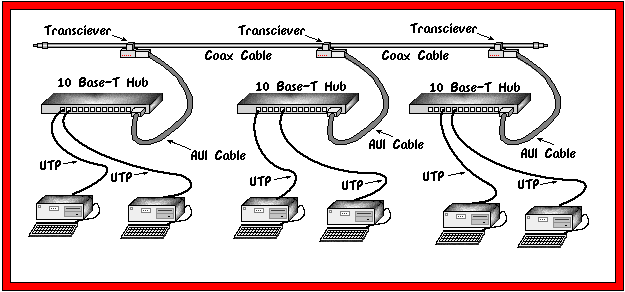Ethernet Basics: Thick Ethernet
Thick Ethernet, officially known as 10 Base-5, is the oldest form of Ethernet. It was originally developed in the late 1970's by Digital Equipment Corporation, IBM, and Xerox, and became an international standard in 1983.
Topology & Cabling
10 Base-5 is laid out in a bus topology, with a single coaxial cable
connecting all nodes together. At each end of the coaxial cable is a
terminator. Each node on the network physically connects to the coaxial
cable through a device called a transciever and an AUI cable is connected
between the node and the transciever. Figure One shows a simple
10 Base-5 network.

Figure One
Thick Ethernet Physical Topology
The cable type used for 10 Base-5 networks is a specialized form of RG-8
coaxial cable. This cable consists of a single central wire surrounded by
a plastic insulation, which is in turn surrounded by four shields and an
outside jacket. The resulting cable is nearly 1/2 inch in outside diameter,
and is relatively heavy and inflexible. However, it is very resistant to
external interferance.
A single 10 Base-5 segment may be up to 500 meters (1650 feet) in length and
may have up to 255 nodes connected to it. Please note that each node must
be at least 2.5 meters (8.25 feet) apart.
Pros & Cons
As with any technology, there are pros and cons to 10 Base-5 which make it
very useful in some applications and not a good choice for others.
Below are some of the characteristics of the technology:
PROS
- Long Distances Possible
- 10 Base-5 allows distances up to 500 meters (1650 feet).
This makes it very useful as a "backbone" technology for wiring
together multiple locations within a building without the use of repeaters.
- Noise Immunity
- Since 10 Base-5 uses a very heavily shielded cable, it can be used in
electrically noisy environments which can cause other network types to fail.
- Conceptually Simple
- Since all devices on a 10 Base-5 network are simply chained together on
a common coaxial cable, it is a simple matter to plan the routing of the
cable. It is also easy to look at the diagram of the network and understand
how a particular installation works.
CONS
- Inflexible
- 10 Base-5 networks do not lend themselves well to installations where
the setup of the network will change much after the initial installation.
It can be very difficult to add or move a node once it is connected to the
coaxial cable.
- Fault Intolerant
- Since 10 Base-5 uses a common physical cable to interconnect all the
nodes, the failure of any part of the coaxial cable or any node has the
ability to cause the entire network to go down.
- Suceptible To Ground Loops
- Ground loops are a notorious weakness of 10 Base-5. Basically, a ground
loop occurs when a network cable is used to interconnect devices which are
powered from different sources, and therefore a difference in voltage exists
between two points on the network. The result is an electrical current
flowing through the shields of the cable, which causes considerale noise to
be introduced into the center conductor.
- Very Difficult Troubleshooting
- As mentioned above, a failure anywhere on a 10 Base-5 segment has the
ability to drop the entire network. Troubleshooting such a failure can be
extremely frustrating, as the only way to do it is to check each node and
the cabling between them one at a time. This is very time consuming, and
can be expensive if a company's entire business relies on the network to be
up.
Today's Applications
Due to the inherent disadvantages in the design of 10 Base-5, it is not
commonly chosen as a technology for the bulk of today's Ethernet networks.
However, it is very useful in specialized applications which take advantage
of its strengths but avoid the technology's weaknesses.
Today, the most common use for 10 Base-5 is as a "backbone"
technology. Basically, a backbone is used to connect together multiple 10
Base-T hubs to create one large network, as depicted in Figure Two.
Another common use is for connecting several distant devices to a central
network.

Figure Two
Thick Ethernet Backbone
10 Base-5 is a good choice for networks which do not require much change
after the initial installation is completed, and which will have only a
limited number of devices attached directly to the coaxial cable.